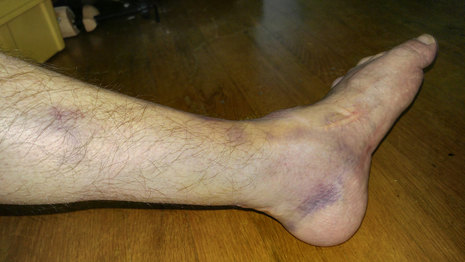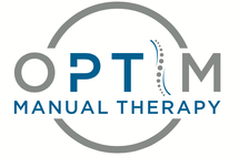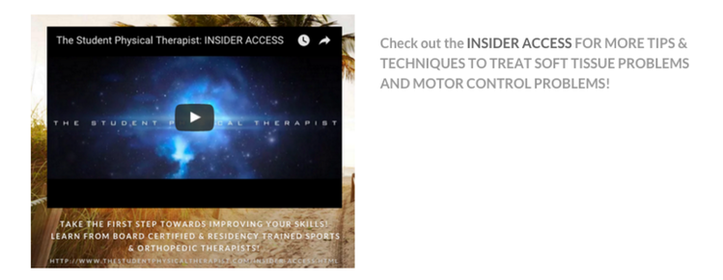- Home
- About Us
- TSPT Academy
- Online Courses
-
Resources
- Newsletter
- Business Minded Sports Physio Podcast
- Day in the Life of a Sports PT
- Residency Corner
-
Special Tests
>
-
Cervical Spine
>
- Alar Ligament Test
- Bakody's Sign
- Cervical Distraction Test
- Cervical Rotation Lateral Flexion Test
- Craniocervical Flexion Test (CCFT)
- Deep Neck Flexor Endurance Test
- Posterior-Anterior Segmental Mobility
- Segmental Mobility
- Sharp-Purser Test
- Spurling's Maneuver
- Transverse Ligament Test
- ULNT - Median
- ULNT - Radial
- ULNT - Ulnar
- Vertebral Artery Test
- Thoracic Spine >
-
Lumbar Spine/Sacroiliac Joint
>
- Active Sit-Up Test
- Alternate Gillet Test
- Crossed Straight Leg Raise Test
- Extensor Endurance Test
- FABER Test
- Fortin's Sign
- Gaenslen Test
- Gillet Test
- Gower's Sign
- Lumbar Quadrant Test
- POSH Test
- Posteroanterior Mobility
- Prone Knee Bend Test
- Prone Instability Test
- Resisted Abduction Test
- Sacral Clearing Test
- Seated Forward Flexion Test
- SIJ Compression/Distraction Test
- Slump Test
- Sphinx Test
- Spine Rotators & Multifidus Test
- Squish Test
- Standing Forward Flexion Test
- Straight Leg Raise Test
- Supine to Long Sit Test
-
Shoulder
>
- Active Compression Test
- Anterior Apprehension
- Biceps Load Test II
- Drop Arm Sign
- External Rotation Lag Sign
- Hawkins-Kennedy Impingement Sign
- Horizontal Adduction Test
- Internal Rotation Lag Sign
- Jobe Test
- Ludington's Test
- Neer Test
- Painful Arc Sign
- Pronated Load Test
- Resisted Supination External Rotation Test
- Speed's Test
- Posterior Apprehension
- Sulcus Sign
- Thoracic Outlet Tests >
- Yergason's Test
- Elbow >
- Wrist/Hand >
- Hip >
- Knee >
- Foot/Ankle >
-
Cervical Spine
>
- I want Financial Freedom
- I want Professional Growth
- I want Clinical Mastery
|
hen I was in my residency, much of the basis of my clinical reasoning and assessment was based on pathoanatomical diagnosis. I would try to determine if the source of low back pain was a herniated disc, spinal stenosis, a combination, or something else entirely. Towards the end of my residency, I was introduced to the advancements of pain science research by Dr. E at The Manual Therapist. It was freeing in some ways. I didn't have to try so hard to diagnose each patient and look for the evidence-backed treatment options. My evaluations became standardized and based partially off repeated motions. I altered my treatment based off patient response and didn't necessarily have to follow the "rules" of anatomy. Instead, my evaluation and treatment focused more on the nervous system and altering the threat level. One of the arguments against a system like this centers around the issue of repetitive microtrauama. Sahrmann has built her Movement Impairment Syndromes (MIS) theory off the belief that repetitive microtrauma and prolonged postures via abnormal movement patterns are responsible for developing abnormal bone growth (via Wolff's Law), degeneration, and then pain. With the development of pain science research, we have learned that there is no correlation between abnormal anatomical findings in imaging and pain. In fact, no long-term study has found repeated motions to directly cause abnormal bone formation. That being said, we must remember certain diagnoses which are directly associated with repetitive microtrauma. For example, spondylolistheses and stress fractures. Now I did discuss last week that spondylolistheses can be found in asymptomatic individuals, but there are cases where they are associated with significant medical problems. Likewise, should a stress fracture not be dealt with in a timely manner, it could lead to bigger issues. So how should we consider pathology? With research pointing more and more towards dismissing pathological findings on imaging, the tendency is to move towards a system completely devoid of it. While this is tempting (as it is easier), there are certain conditions that we should be aware for potential relevance. Now it is not necessary to have imaging to support these conclusions, but instead we should use patient presentation and response to dictate our management. Should a patient with low back/LE pain and/or N&T present with bowel and bladder issues or saddle anesthesia, refer the patient to imaging. In general, if you are not making progress with a patient after a month of treatment they should be referred back to the doctor. There are certain conditions that mandate being aware of pathology and for that reason alone, we shouldn't be so quick to abandon them. -Dr. Chris Fox, PT, DPT. OCS
2 Comments
Robbie Horstman
10/11/2016 06:31:06 pm
Good food for thought. I approach the concept with my gut feeling as my first indicator. I see at least a few patients daily with whom I use pain science education minimally. There are also those with whom I spend 75% of treatment time on it. Presentation is important, but so are patient beliefs/misbeliefs. A thoughtful, discerning approach is necessary; there are cases where pathoanatomy is 80%... Others where it's 5%... After all, a compound fracture will hurt at some point :)
Reply
6/15/2024 09:16:52 pm
Medical supplies and equipment are essential components of healthcare, ensuring that medical professionals can provide high-quality care to patients. From basic items like bandages and syringes to advanced diagnostic tools and life-support machines, these supplies are critical for patient diagnosis, treatment, and recovery. Choosing reliable suppliers is crucial, and this is where customer feedback becomes invaluable. For instance, Vitality Medical reviews often highlight the quality, durability, and effectiveness of various medical products. By consulting these reviews, healthcare providers can make informed decisions, ensuring they select the best equipment to meet their patients' needs and improve overall care outcomes.
Reply
Leave a Reply. |
Dr. Brian Schwabe's NEW Book in partner with PaleoHacks!
Learn residency-level content on our
Insider Access pages We value quality PT education & CEU's. Click the MedBridge logo below for TSPT savings!Archives
July 2019
Categories
All
|









 RSS Feed
RSS Feed